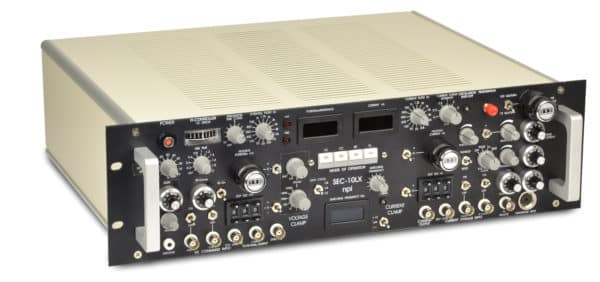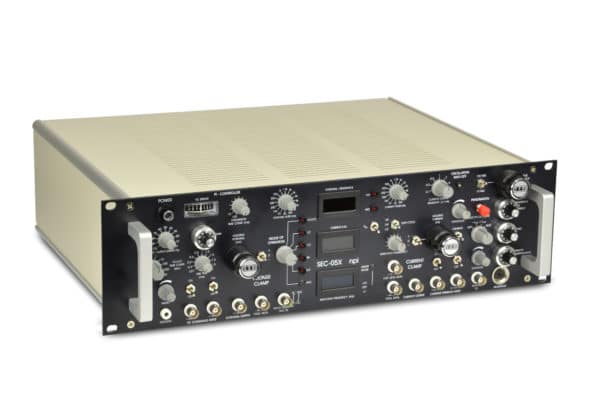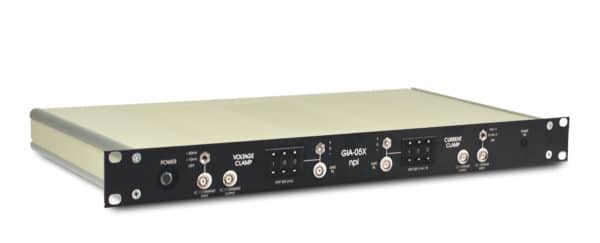npi‘s SEC amplifiers are versatile current clamp and voltage clamp amplifiers which permit extremely rapid switching between current injection and current-free recording of true intracellular potentials.
The SEC series comes with a dSEVC (discontinuous Single Electrode Voltage Clamp) and dSECC (discontinuous Single Electrode Current Clamp) with continuous bridge mode. The amplifiers inject current and record the potential in an alternating mode (switched mode). This ensures that no current passes through the access resistance during potential measurement and completely eliminates artefacts caused by the access resistance.
The use of precise electronics and an innovative method of capacity compensation makes it possible to inject very short current pulses through high resistance microelectrodes (up to 200 MΩ and more) and to record membrane potentials accurately, i.e. without series resistance error, within the same cycle. This allows to record with high accuracy also from small cells that do not allow penetration of two electrodes.
Although the system has been designed primarily to overcome the limitations related to the use of high resistance microelectrodes in intracellular recordings, it can also be used to do conventional whole-cell patch-clamp recordings or perforated patch recordings. The whole-cell configuration allows to investigate even small dissociated or cultured cells as well as cells in slice preparations in both current and voltage clamp mode, while the intracellular medium is being controlled by the pipette solution. Read more…



The use of sharp electrodes is possible in contrast to patch clamp amplifiers. This conserves the intracellular milieu of the recorded cell. Furthermore, the great advantage compared to the whole cell recording method using a patch amplifier is the elimination of series resistance due to the time-sharing protocol. No current flow during voltage recording means no interference from the series resistance regardless of its value. Voltage clamp recordings are possible with sharp microelectrodes in deep cell layers.
Series resistances do not exist due to the fact that potential measurement is done at a time when no current injection takes place.
This is the frequency at which voltage measurement and current injection alternate.
This is the ratio between current injection and potential recording mode.
npi’s SEC amplifiers use a special method for compensation the stray resistance of the recording electrode. This makes very short potential recording and current injection times possible.
Yes, the SEC amplifiers have a bridge mode or a switch current clamp mode for accurately membrane potential recording and current injection.
Yes, the SEC amplifiers have telegraphs for current sensitivity and filter settings.
The “Voltage Clamp controlled Current Clamp” (VCcCC) or “slow voltage clamp“ (Slow VC) mode is used for performing accurate current clamp recordings with pre-set resting potentials in the presence of membrane potential oscillations. Slow membrane potential oscillations are exactly controlled by the voltage-clamp module without affecting faster responses, e.g. postsynaptic potentials (PSPs) and action potentials (APs).
You can set stimulus amplitudes manually with the amplitude potentiometers. Once set the stimulus can be gated with a standard TTL pulse (+ 5V). This function can also be added to an SEC-05X amplifier by using a gating unit GIA-05X (to be purchased separately).
Each amplifier of the SEC series comes in a 19″ rackmount cabinet and is equipped with functions like penetration mode, an oscillation shut-off circuit for protecting the preparation, telegraphing of current sensitivity and filter settings, a PI controller for voltage clamp mode and an audio monitor. Switching frequency and duty cycle can be set. The amplifier is equipped with a headstage with a holding bar. The electrode holder is connected with an electrode holder adapter that can be attached directly to a micromanipulator.
The SEC-05X is the standard amplifier for intracellular current clamp and voltage clamp recordings.
The SEC-10LX has the same features as the SEC-05X and in addition push buttons for modes of operation, more detailed settings of the penetration mode, 4-pole Bessel filters by default and the possibility to gate stimulus steps.
A single electrode amplifier is also available as module for the EPMS-07 system (SEC-03M).

Our dedicated team has years of industry and laboratory experience.
From complex technical challenges to tailored product recommendations,
our application scientists are ready to support your needs with hands-on expertise.